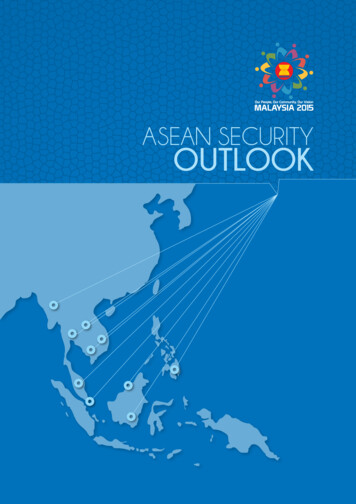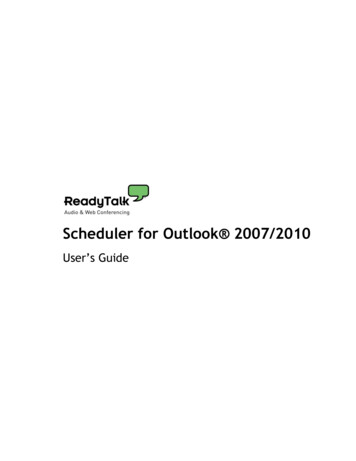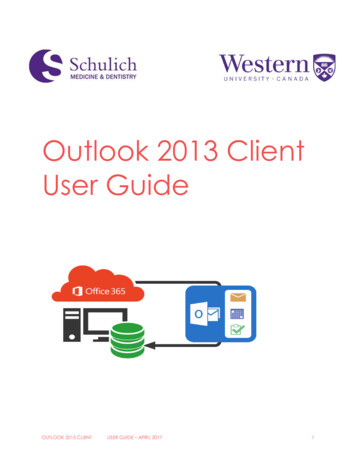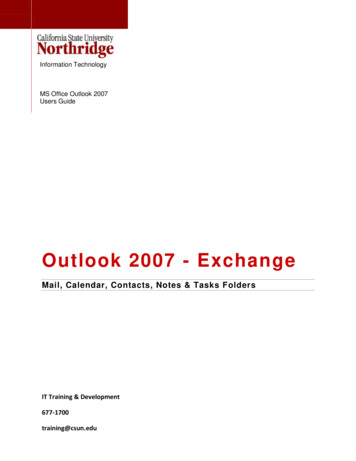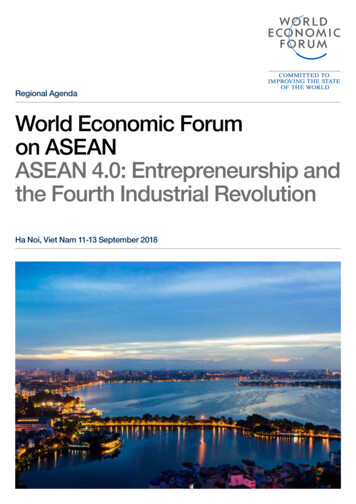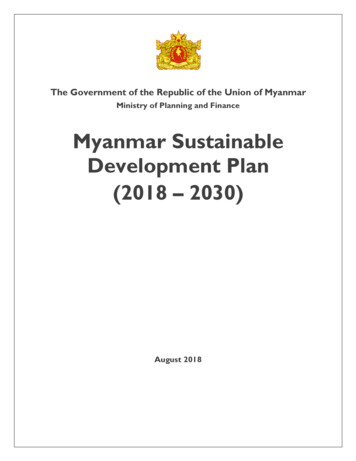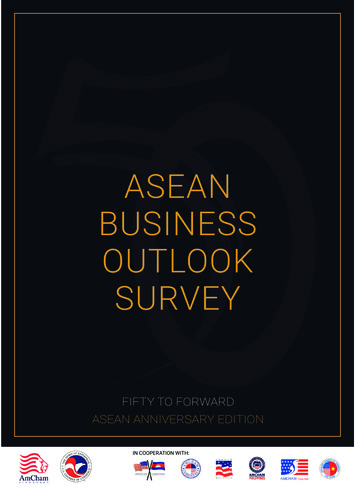
Transcription
ASEANBUSINESSOUTLOOKSURVEYFIFTY TO FORWARDASEAN ANNIVERSARY EDITIONIN COOPERATION WITH:
Executive MBA Program
CONTENTS3Foreword from the U.S. Chargé d’Affaires to ASEAN4Preface from AmCham Singapore and the U.S. Chamber of Commerce5ASEAN and the United StatesCEO PERSPECTIVES6Riding the ASEAN Tigers9What Business Leaders on the Ground in Singapore Are SayingASEAN BUSINESS OUTLOOK SURVEY 201812Executive Summary131. Economic Outlook202. Global Relations & Trade Agreements243. ASEAN Economic Integration274. Business Expansion In ASEAN305. Workforce Demographics346. SME Outlook377. Current Local Business Environment398. Change in Satisfaction of Local Business Environment (2012 vs. 2017)COUNTRY PROFILES40Brunei Summary Report42Cambodia Summary Report44Indonesia Summary Report46Laos Summary Report48Malaysia Summary Report50Myanmar Summary Report52The Philippines Summary Report54Singapore Summary Report56Thailand Summary Report58Vietnam Summary ReportSPECIAL PERSPECTIVES61SMEs Making a Difference in Southeast Asia62Transforming Lives: American Corporate Citizenship in Action72Business Leaders’ Perspectives74Profile of Respondents76Survey Methodology77AcknowledgmentsASEAN BUSINESS OUTLOOK SURVEY 20181
Why Choose GEMS World Academy (Singapore)? The Future School: Global initiativessuch as our ground-breaking BlendedLearning, STEM programme and focuson entrepreneurship ensures that theeducation our students explore today,supports their aspirations for the future Internationally Certified Curriculum:Our 18 World School status, CambridgeInternational School accreditation andEduTrust certification enables familiesto join us from anywhere in the world,to move anywhere in the world International Educators: Committed andchild-centred, our globally experiencedteachers are the true difference for ourinternational students Parent Engagement: Our parents areactive partners with us in communityservice and parent engagementopportunitiesGEMS World Academy (Singapore) is owned by GEMS Education, the world leader in K-12 educationCONTACT US NOWPRE-K TO GRADE 12 ,,,, 0· No8':::. CAMBRIDGElnternatmnal ExammatrnnsCambridge International School(S) 65 6808 7300r c. ,. IE! info@gwa.edu.sgWEAREA MEMBERSCHOOLCertno.:EDU-2-2082 trust""c"o"validity:27/01no16-26/0112020CPE Registration Number: 200803726H. Registration Period: 19 March 2017 to 18 March 2021.ESEDUCATION www.gwa.edu.sgEWorld Academ (Singapore)
FOREWORD FROM THE U.S.CHARGÉ D’AFFAIRES TO ASEANIt is my pleasure to introduce the 2018 Association ofSoutheast Asian Nations (ASEAN) Business OutlookSurvey, a resource the American Chamber of Commercein Singapore publishes each year. Southeast Asia, withstrong and sustained growth, a young population, anda rapidly expanding middle class, continues to be full ofexciting business opportunities. The survey offers anaccessible summary of the perceptions and insights ofU.S. executives about the region.The United States highly values its multi-faceted relationshipwith ASEAN. Vice President Mike Pence’s meeting with theASEAN Committee of Permanent Representatives in Apriland Secretary Rex Tillerson’s meeting with ASEAN ForeignMinisters in May are only the most visible examples of ourcontinuous and productive engagement at every level.U.S.-ASEAN Connect, our framework for all U.S. economicengagement in ASEAN, builds upon the already strongties between the United States and ASEAN to expand oureconomic relationship and support the ASEAN EconomicCommunity. Our efforts this year will continue to focus onbusiness, innovation, energy, and economic policy. Ourflagship Digital Economy Series highlights the importanceof this sector and ASEAN’s potential.building an integrated, dynamic, innovative, sustainable,and resilient Economic Community that benefits all citizensof the region – because that also benefits U.S. businessand exports.ASEAN is the United States’ fourth-largest trading partnerand a fast-growing investor. U.S. exports to ASEAN supportover 500,000 U.S. jobs, spanning every state. Through theU.S.-ASEAN Trade and Investment Framework Arrangement,we are working to further expand trade ties and promotefree and fair trade.In 2017, the United States and ASEAN are marking the 40thanniversary of our relationship, as ASEAN celebrates 50years of progress. Vice President Pence noted that PresidentTrump is enthusiastic “to join the U.S.-ASEAN Summitduring the golden anniversary year of this organization.”The United States and ASEAN are committed to workingtogether to build an even stronger relationship to deliverprosperity and opportunity for all our people.The U.S. private sector, which is one of the leading investorsin ASEAN and which brings millions of jobs, world-classtraining, cutting-edge technology, and extensive communityinvestment to Southeast Asia, is our close partner in U.S.ASEAN Connect. Together, we support ASEAN’s goal ofDaniel ShieldsChargé d’Affaires, a.i.U.S. Mission to ASEAN in JakartaASEAN BUSINESS OUTLOOK SURVEY 20183
PREFACEPREFACEFROMFROMAMCHAMSINGAPOREAND THE ANDAMCHAM SINGAPOREU.SCHAMBEROF COMMERCETHEU.S. CHAMBEROF COMMERCEThis special commemorative edition of the ASEAN BusinessOutlook Survey celebrates ASEAN’s 50th anniversary andthe U.S.-ASEAN Dialogue Partnership’s 40th in 2017. We aredelighted to mark this important milestone with an expandedin-depth survey of U.S. business operations in the regionthat explores and explains executives’ views of the region’sopportunities and challenges. ASEAN has long been animportant U.S. trading partner, a major destination for U.S.investment, and a vital set of links in U.S. companies’ globalsupply and global value chains. Many American companieshave been in Southeast Asia for decades, in some caseseven before the existence of ASEAN itself. The relationship’shistory is long, its breadth is vast, and its roots are deep.For more than a decade and a half, the ASEAN BusinessOutlook Survey has been an unmatched guide to U.S. businessand investor sentiment in the region. This commemorativeedition of the survey continues our tradition of providing theinvaluable insights and perspectives of senior executivesfrom U.S. companies in all ten ASEAN countries. Many of thesurvey’s questions have been asked for several years running,and the trends in the responses over time yield fascinatinginsights. At the same time, some portions of the survey areupdated every year to reflect current developments and topicalissues and priorities. This year is no exception.In our preface to last year’s survey, we noted that it cameat “a challenging and uncertain time for global business”in the wake of the Brexit decision, challenges in China, andanti-trade rhetoric in the U.S. election campaign. Since then,the environment has become even more complex. The Brexitprocess looks to be long and drawn out, challenges withinand emanating from China are many and varied, and theTrump Administration’s withdrawal from the Trans-PacificPartnership and its unsettled trade policy (as of this writing)mean that, if anything, the uncertainties are even greater.4This special edition of the ASEAN Business Outlook Surveyincludes, for the first time, a focus on small and mediumenterprises and features in-depth interviews with executivesrepresenting a broad array of businesses in the region.The ASEAN Business Outlook Survey is a collaborative effortbetween the American Chamber of Commerce in Singaporeand the U.S. Chamber of Commerce, with support from theAmerican Chamber of Commerce in Cambodia, the AmericanChamber of Commerce in Indonesia, the American MalaysianChamber of Commerce, the American Chamber of Commercein the Philippines, the American Chamber of Commerce inThailand, the American Chamber of Commerce in Vietnam(Hanoi), the American Chamber of Commerce in Vietnam (HoChi Minh City), American Chamber of Commerce chapters inLaos and Myanmar, and American business leaders in Brunei.We are grateful to our AmCham partners for their supportin this effort, and to the many companies who havegenerously contributed in this year’s special edition ofthe Survey, including Accenture PLC, AIG, Cargill, Citi,Cognita, Edwards Lifesciences, Ford, HP Inc., IBM, Johnson& Johnson, Kimberly-Clark, Microsoft, Milbank, Ogilvy &Mather Singapore, Organisation Solutions, Otis, Procter &Gamble, Seagate, Sealed Air, Singapore American School, SunElectric, The Coca-Cola Company, UPS, Visa, and Xylem WaterSolutions Singapore. At a time of unprecedented challengeand uncertainty in the region, we believe that the Surveywill be more valuable than ever. As always, we welcomeyour feedback, and encourage you to send comments andsuggestions to aseansurvey@amcham.org.sg or jgoyer@uschamber.com.Ashley Rossi McInerneyTami OverbyInterim Executive DirectorAmCham SingaporeSenior Vice President, AsiaU.S. Chamber of CommerceASEAN BUSINESS OUTLOOK SURVEY 2018
ASEAN ANDTHE UNITED STATESIn 2017, the United States and ASEAN celebrate 40 years ofpartnership working toward stability, prosperity, and peacein Southeast Asia. The relationship began in 1977, 10 yearsafter the establishment of ASEAN, when the United Statesfirst engaged with ASEAN as a dialogue partner. Focusedon issues of trade and investment, technology transfer,and education, both parties expressed a desire to developrobust relations and mutually beneficial cooperation.Since that time, the U.S. and ASEAN have strengthenedties in addressing economic development and regionalsecurity. In 2006, the two announced the ASEAN-U.S.Enhanced Partnership Agreement, marking a new phase ofU.S.-ASEAN relations. In 2008, the United States openedthe U.S. Mission to ASEAN, and, with the appointment ofAmbassador Scot Marciel, became the first non-ASEANcountry to name an ambassador to ASEAN. The U.S.and ASEAN have continually joined under commoncommitments to rule of law and regional prosperity toaddress a range of political and security issues for thepeace and stability of the region. Joint initiatives havestrengthened economic integration of ASEAN nations ininternational trade flows, while simultaneously seekingto address global security threats, ensure maritimecooperation, and launch programs for the developmentof ASEAN’s future leaders.“ASEAN is the most competitive region forU.S. businesses, with high adaptability,innovativeness, and a large pool of skilledand unskilled resources.”ABOS 2018 Survey RespondentIn 2016, the U.S. hosted the first ever standalone U.S.ASEAN summit in California, highlighting the U.S.commitment to ASEAN. At the conference, U.S.-ASEANConnect was launched. Serving as a strategic frameworkfor economic engagement with ASEAN and its member“ASEAN as a whole is animportant and dynamic marketwith tremendous growth potentialin years ahead. It is critical thatthe U.S. maintains strong andpositive relations with ASEAN.”ABOS 2018 Survey Respondentstates, Connect reflects a mutual desire of ASEAN andthe U.S. to continue to pursue economic integration,trade, and investment. By addressing issues rangingfrom e-commerce and entrepreneurship to clean powerand the trade environment, Connect paves new roads forthe U.S. and ASEAN to promote economic growth andcooperation throughout the region.Today, ASEAN is the United States’ fourth-largest tradingpartner and fourth largest export market. The UnitedStates is the largest single foreign direct investor in theASEAN region, with over US 306 billion1 in investment andnear 4,7002 companies in the region. American companysales in ASEAN account for 10% of their total global sales,and generate over 20% of ASEAN’s total exports of goodsand services.3Over the past 40 years, the U.S. and ASEAN have developeda connection and interdependence that will continue tostrengthen as programs emphasizing energy cooperation,people-to-people exchanges, innovation, and policycontinue to expand the relationship. Through sharedprinciples of dynamic growth, together ASEAN and theU.S. are primed to capitalize on emerging opportunitiesthroughout the region.Bureau of Economic Analysis, U.S. Department of Commerce, 2017. http://www.bea.gov/scb/pdf/2017/07%20July/0717 direct investment positions tables.pdf Trade & Investment, US-ASEAN Business Council, Inc. www.usasean.org/why-asean/investment 3“ASEAN Investment Report 2016”, UN UNCTAD and ASEAN, p.78. http://unctad.org/en/PublicationsLibrary/unctad asean air2016d1.pdf 12ASEAN BUSINESS OUTLOOK SURVEY 20185
CEO PERSPECTIVESRIDING THE ASEANTIGERSBY ANGELA MANCINISpeaking with the CEOs of several largemultinational member companies of the AmericanChamber of Commerce in Singapore, the messageis resoundingly clear: ASEAN has been an importantmarket for their companies’ business growth overthe past 50 years, and prospects for the next 50look even brighter.solutions with Otis well positioned for the planningand implementation.”This growing middle class will also need an arrayof products and services to meet their needs inareas such as healthcare, food, and other consumerproducts. In light of this, leading Americancompanies in the region are investing in new orAmerican companies have been operating in the expanded facilities in several ASEAN countries,region for a long time, many since well before the reflecting their optimism about the region.formation of ASEAN 50 years ago. Many havedeveloped a significant footprint in the region, riding “We have seen steady growth momentum over theon the coattails of its dramatic growth. “ASEAN is past 10 years and we forecast that between nowhome to a range of economies in different cycles, and 2022 the ready-to-drink market will almostranging from developed to emerging and frontier double,” said Iain McLaughlin, President, ASEANmarkets, and its combined GDP already makes Business Unit, The Coca-Cola Company. “For us,it the fifth-largest economy in the world with the ASEAN is viewed as one of the key growth driversthird-largest population,” said Amol Gupte, Head of for the business overall, and we, together with ourASEAN and Citi Country Officer for Singapore, Citi. bottling partners, are investing to be in a position tocapture that growth. In addition to China or India,And there’s little reason to doubt that ASEAN’s ASEAN has considerable growth potential in theoutlook will remain rosy; the region is well supported short-term.”by favorable demographics, rising investmentand trade flows, increased urbanization, and a The relative stability of ASEAN’s macroeconomicburgeoning and well-connected middle class. An and investment climate also favors businessestimated 60% of the region’s population is under 35 growth. Many, too, see the continuation of a strongyears old, pointing to an abundant pool of labor and U.S. presence in the region as a key plank inlatitude for consumption to grow further. It helps building strong bilateral and regional relationships,that this demographic is tech-savvy and highly as well as promoting business opportunities. “Weconnected, too. E-commerce is still in its infancy in are a U.S. corporation and it is very important toASEAN and is poised to grow exponentially in the have strong relations not only between the U.S. andcoming years. These factors, coupled with an ever- individual countries in this region, but between thegrowing internal market, make the region extremely U.S. and ASEAN overall. It is important for the U.S.attractive to investors.to make continued strong relations with ASEAN apriority of the administration,” said McLaughlin.The continued urbanization of the population inASEAN is a major factor spurring growth across the Other business leaders echoed this sentiment.region. According to Ryan Mai, President of South Citi’s Gupte said, “Given the potential for theAsia Pacific at Otis, only about half of ASEAN’s region, the U.S. administration must stay engagedpopulation of 640 million lives in urban areas, and work with local governments here to openleaving much room for housing and infrastructure up opportunities for U.S. companies that areexpansion. “This megatrend of urbanization is very committed to invest and grow in the region.”relevant for our industry. Many of the countriesacross ASEAN are realizing that smart, progressive Golden Ageurban planning is very critical to their future All of these companies have benefited from strongdevelopment. This in turn will drive the demand for growth across ASEAN through the years. Coca-Colaadvanced vertical transportation technologies and has just celebrated its 105th year in the Philippines,6ASEAN BUSINESS OUTLOOK SURVEY 2018
CEO PERSPECTIVESand its 91st in both Singapore andMalaysia. As the only consumer productscompany that has been present in all themarkets of ASEAN since its formation,Coca-Cola has an operating presencein the 10 member countries of ASEAN,with multiple manufacturing locationsin countries such as Indonesia and thePhilippines.that provides functional services acrossits global operations.Promising PartnershipsApart from developing large businessoperations in the region, many U.S.companies have focused on buildingdeep, long-term partnerships withgovernments and local authorities acrossASEAN to develop sustainable growthOtis, which was founded in 1853, was the for their businesses and to support localfirst elevator company to be established communities.in Singapore in 1949. One of its firstelevators installed in Singapore is at In 2014, Johnson & Johnson chosethe Salmon Maternity Home in Prinsep ASEAN as the first region to introduce itsStreet, which still exists today. While it innovative “One J&J” operating model.still produces elevators and escalators, Under this initiative, Johnson & JohnsonOtis is transforming its business to better unified its operations under one group toconnect the customers, employees, capitalize on opportunities and to drive itsand products to create a global digital partnerships with governments, helpingecosystem that will provide the advance countries’ healthcare agendas.customers with more information and For example, it is working with theimproved uptime. “We are transforming governments of Thailand, the Philippines,our business, leveraging digitalization and Vietnam, and Indonesia to fight thetechnology to better serve our customers’ disturbing rise of multi-drug resistantchanging needs,” said Mai.tuberculosis. “Operating as one, we arein a much more meaningful position toHP Inc., which has been present in ASEAN partner with governments to understandfor 47 years, has sales operations in their agenda and mobilize assets thatSingapore and a new manufacturing plant will be useful for them,” said Ai Hua Ong,in Penang. It also has a team that runs a President of Southeast Asia, Johnson &supply-chain operations control tower Johnson. “We are very aware there arefrom Singapore to manage production rising healthcare needs alongside theand the movement of goods for all of HP’s rise of the middle-income population, butplant locations globally.there are constraints on governmentsin terms of healthcare budgets. TheCiti, which has played a central role in issue is how we work with each of thethe development of the ASEAN financial governments in each of the countries tosector since 1902, has been able to tap find an optimal position where innovationASEAN’s plentiful pool of labor. “In 1971, is being encouraged but also how can weCiti had 150 employees in Singapore. partner to address costs as well.”Today, we provide employment to 9,000individuals, making Citi the largest foreign Cognizant of the need to develop localbanking employer in Singapore,” said talent across the region, Johnson &Gupte. With 40% of its Asia-Pacific staff Johnson has also led efforts to train localbased in ASEAN, Citi has state-of-the- healthcare professionals. In Vietnam, itart processing hubs and data centers in partnered with Harvard University andSingapore, Malaysia, and the Philippines Vietnam University to advance medicalthat serve more than 90 countries around and surgical education under an initiativethe world.that President Obama highlighted on histrip to the country in 2016.Johnson & Johnson made its foray intoASEAN more than 60 years ago, when it At the local community level, U.S.launched its operations in the Philippines. companies are forming partnerships toIt runs its Asia-Pacific operations from help ensure long-term sustainable growthSingapore and has a large team in Manila through local workforce development andsupport for environmental sustainability.Coca-Cola, for one, achieved “water usageneutrality” for its operations in ASEAN in2016, partly through its conservation andreforestation projects. The company alsoruns the STAR program in the Philippines,which trains owners of “sari-sari” (frontof-home) stores, 85% of whom arewomen, on effective retail and financialmanagement. Since its inception, theprogram has trained more than 80,000women in the Philippines and over200,000 women across ASEAN, accordingto Coca-Cola’s McLaughlin.Spurring InnovationA recurring theme cited by these businessleaders is the attractiveness of ASEAN asa location to drive innovation across theirbusinesses.HP Inc., for example, positions itself on thecutting edge of technological and socialchange, and uses its ASEAN operations todrive innovation. “We are very aware of thenew model of how and where people work,and how that is evolving across ASEAN,”said Kong Meng Koh, General Managerand Managing Director, Southeast Asiaand Korea, HP Inc. “We don’t really havea traditional office anymore. For manypeople, you work where you are, whetherthat is at a customer location or coffeeshop.” This trend is behind HP Inc.’s driveto lead the way on portable products andrelated security features.HP Inc. is also developing 3D printingsolutions, which it aims to make aslow cost and mainstream as possibleacross ASEAN and beyond. Koh said,“We envision a system where, say, acustomer in southern Myanmar can ordera customized product to be printed at a3D server farm in Yangon and have itdelivered the next day.” He sees ASEANas a unique market for these innovativetechnologies because, being an emergingmarket with solid government supportfor these initiatives, it is able to leapfrogolder technology. He further noted thatcompanies like HP Inc. are well placedto help governments get their technologyand supporting infrastructure right.ASEAN BUSINESS OUTLOOK SURVEY 20187
CEO PERSPECTIVESOtis has also been at the forefront ofdriving change in the region. “We aremoving forward with investments thatare helping to support Singapore’s ‘SmartNation Vision,’” said Mai, referring to theRepublic’s drive to transform the way itdoes things by tapping into the excitingpossibilities opened up by technology.“The technology is evolving very quickly.We are moving toward using remotediagnostics and intervention to anticipateproblems and conduct proactive, remoterepair. But at the end of the day, we alsostill need a human element, that is, peoplewho can talk to customers and provideanswers.”As companies leverage technologyand push ahead with digital innovation,business leaders are ready to provideinputs into policy-making considerations.Gupte says, “Policies should be determinedby the evolving nature of digital interactionand the infrastructure that supportsthat exchange. Increasingly informationtechnology has come to underpin allcommunications and interactions intoday’s globally connected economies.In considering the implication of thedigital economy for financial services,ASEAN policy-makers must establish acommon cybersecurity framework, buildon the ASEAN integration framework,and promote financial inclusion forsustainable development. The leadersof the region must continue prioritizingcollaboration and integration.”50 Years HenceEven as ASEAN abounds with businessopportunities, investors do face certainchallenges. Infrastructure, particularlyroads and ports, remains a majorlogistical challenge for investors wishingto move raw materials or finished goodsseamlessly across the region. “I wouldlike to see better integration amongthe ASEAN nations in terms of travel,transport, and logistics. We will see highspeed rail from Singapore to Malaysia.Why not all the way from Singapore toBangkok or Hanoi?” asked HP’s Koh.Simpler business-friendly laws anda higher degree of transparency inthe development and enforcementof regulations would help ensure fair8ASEAN BUSINESS OUTLOOK SURVEY 2018competition and provide a favorableenvironmentfornewinvestment.Business leaders say there is a need forregulatory harmonization, particularly inissues such as product safety, contentrequirements, and labeling. Anotherimportant issue is the global quest fortalent. While many business leaderscite the need for increased investmentin high-quality and technical educationacross the region, some governmentsare finding it difficult to fund manpowerdevelopment.Otis, which has been involved in iconicprojects in Singapore such as Gardensby the Bay, the Swissotel, and AXATower (originally the Temasek Tower) isfocusing on developing a highly skilledworkforce. “The whole value chain ofour products, from installation to testingand maintenance requires highly skilledhuman resources,” said Mai. Building astrong and capable workforce is aboutformulating policies that are gearedtoward developing skills,” he noted. “Ifcountries can marry technology withhuman capability, particularly in the area ofSTEM (science, technology, engineering,and mathematics), skills enhancementwill help address recruitment challengesin many ASEAN markets.” Otis, which ispart of United Technologies, believes thatas the world continues to change, it iscritical to learn and evolve to meet thosechallenges and remain competitive. Thatis why the company offers its EmployeeScholar program to encourage andpromote the education and developmentof its employees and empower them toexpand their knowledge in their currentfield or learn new skills for a different careerpath. Since its introduction 20 years ago,United Technologies has invested morethan US 1.2 billion and employees haveearned approximately 35,000 degreesunder the scholar program.There is also a need to boost intra-ASEANtrade. A significant milestone in ASEAN’sevolution has been the establishment ofthe ASEAN Economic Community (AEC) in2015, which will help drive integration andbusiness growth across the region. SaidGupte of Citi, “In order to boost ASEAN’scompetitiveness in the international arena,I urge leaders in this region to continueprioritizing collaboration and integration.Not losing sight of our common goals iscrucial to ASEAN’s success in the nextdecade.”One area where the AEC could helpspur intra-regional trade is regulatoryharmonization. According to McLaughlin,it is not uncommon for Coca-Cola to have10 or 12 different labeling requirementsacross the region for the same product.He said, “The AEC gives us the opportunityto harmonize our supply chain. Whencombined with better infrastructure, thatwould be a great benefit for us. There aremany opportunities to harmonize and shipacross borders, which we really aren’t in aposition to take advantage of today.”Speaking volumes of the region’sdynamism, the leaders all noted thattheir companies’ successful growthstories have mirrored ASEAN’s and theyhope this will to continue. “We definitelysee abundant opportunities becausedemographics and the rise of the middleincome class are strong. ASEAN as agroup is successful in governing andbeing able to address opportunitiesand tackle issues as one. Unlike the EU,which is newer, ASEAN has proven itseffectiveness over a long period of time,”said Ong of Johnson & Johnson.Indeed, ASEAN has grown beyond allexpectations and, in Ms. Ong’s words,“is more than just a model of strongeconomic development.” In the next lap,ASEAN has an excellent opportunity toshow the world how this can be done.
CEO PERSPECTIVESWHAT BUSINESS LEADERSON THE GROUND INSINGAPORE ARE SAYINGBY TOM BENNERGROWTH AND OPPORTUNITY. EXPANDING MARKETS. BUSINESSFRIENDLY. AN EDUCATED WORKFORCE. STABILITY. GLOBAL REACH.Talk with executives at some of the leading U.S. companies that have planted roots inSingapore and Southeast Asia, and those phrases keep coming up.2017 marks the 50th anniversary of ASEAN – the Association of Southeast Asian Nations,which has made huge strides in promoting its three pillars of social, political, and economicsecurity among its 10-member nations: Brunei, Cambodia, Indonesia, Laos, Malaysia,Myanmar, the Philippines, Singapore, Thailand, and Vietnam.A recent advancement is the creation of the ASEAN Economic Community (AEC), an economicintegration project to create a common market and a single production base, allowing for thefree flow of goods, services, investments, capital, and skilled labor within the region.2017 also marks the 40th anniversary of the U.S.-ASEAN Dialogue Partnership, created topromote exchanges, cooperation, and partnerships that continue to thrive and grow.So what is happening on the ground? Here are a few observations.Chris Riley is Group Chairman of Ogilvy & MatherSingapore. Headquartered in New York City,Ogilvy & Mather is one of the largest marketingcommunications companies in the world, with apresence in Asia since the early 1950s, and withsome 400 employees based in Singapore andseveral thousand across ASEAN.Longevity and growth are important themes forRiley. He stated Ogilvy’s Asian presence allows thefirm to help its global clients such as IBM, Unilever,and Allianz to expand into emerging markets – aswell as to take on local and regional clients, suchas Singapore’s Ministry of Culture, Community andYouth, and SingTel, a regional telco brand with biginternational ambitions.In fact, Ogilvy’s deep roots in Singapore took onspecial significance when the firm was awardedthe assignment to lead communications effortsfor SG50, the nationwide celebration of Singapore’s50th anniversary as an independent country in2015.“It was a huge moment for the country, and to playa sign
Executive MBA Program C M Y CM MY CY CMY K A4 - ABOS outlined.pdf 1 6/27/2017 2:34:11 PM CONTENTS CEO PERSPECTIVES Riding the ASEAN Tigers What Business Leaders on the Ground in Singapore Are Saying Foreword from the U.S. Chargé d'Affaires to ASEAN Preface from AmCham Singapore and the U.S. Chamber of Commerce ASEAN and the United States
